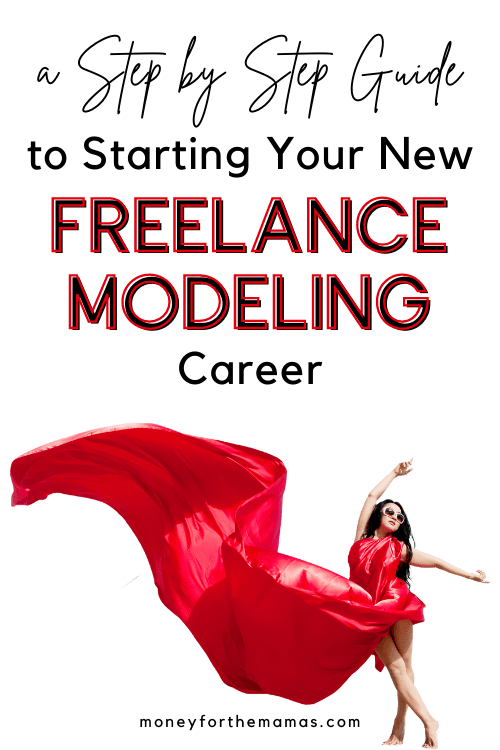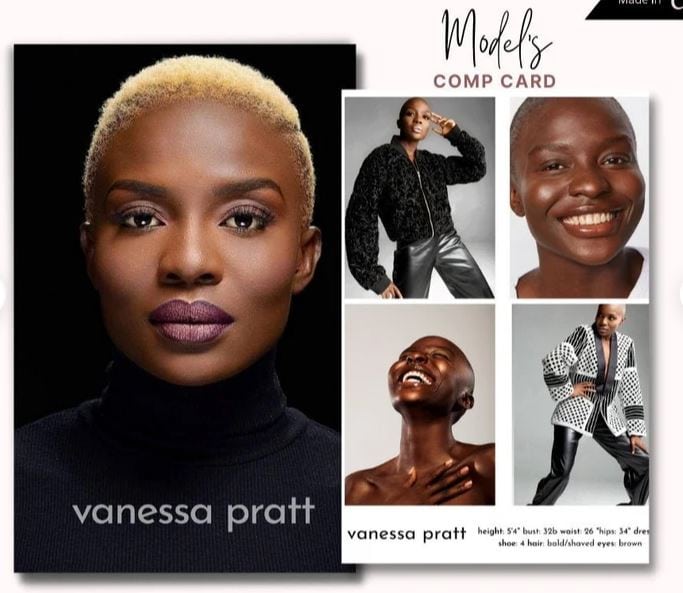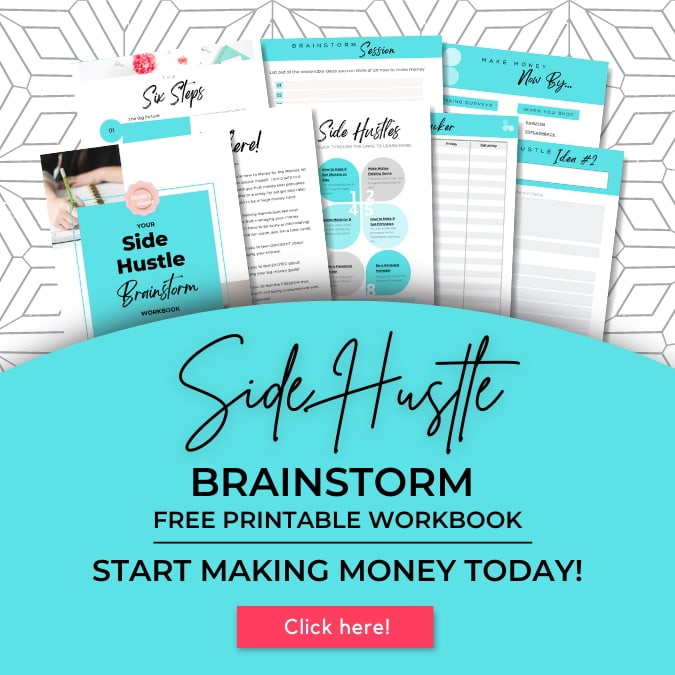A Step by Step Guide to Starting Your New Freelance Modeling Career
Let’s break down the 4 simple steps to becoming a freelance model and the tips & skills you need to nail to become a rising star!

Author: Kari Lorz – Certified Financial Education Instructor
You’ve seen them at fashion shows, on the runway, and in magazines. If you’re interested in freelance modeling as a career, this article will tell you everything you need to know about how freelance models get started and become successful.
Plus, we’ll go through some insider tips so you can hit the ground running with your new side hustle, and soon to be career (as you’re going to be amazing)!

This post may contain affiliate links. If you make a purchase, I may make a commission at no cost to you. Please read my full disclosure for more info
- Let's break down the 4 simple steps to becoming a freelance model and the tips & skills you need to nail to become a rising star!
- What is a freelance model?
- What's better – Doing freelance modeling or with a modeling agency?
- What are the different kinds of modeling?
- How much money can you make with a freelance modeling career?
- How much do Instagram models make?
- How to become a freelance model – the exact process step by step
- Freelance modeling tips & skills needed to be successful
- Modeling red flags and scams
- At the end of the day
What is a freelance model?
Freelance models work for themselves and don’t have an employer hiring them (like a model agency). They may be hired by companies looking for freelance models, or they may choose to offer their services independently through networking or advertising.
As a freelance model, you will be representing yourself and are responsible for finding and booking your own gigs or work, versus having an agency find your work.
What’s better – Doing freelance modeling or with a modeling agency?
Choosing to model freelance, as opposed to having a contract, gives you more flexibility over the clients you want to work with and what type of modeling career you want. You also get to decide how much work you want to take on, so it’s great for just part-time work.
One of the biggest bonuses of working on your own is that you get to keep the entire paycheck (no fees go to the agency), yet you may still need to pay for the makeup, hair, etc. (if it wasn’t included in your job contract).
Being a freelancer also means that you have control of your “look.” Many models complain that they have to look a certain way or can’t change their appearance due to contracts. (This means you can dye your hair, get a tattoo, or do whatever, whenever you want).
Yet, it can be more challenging to get started as an aspiring model, as you’ll need to have a strong portfolio of work and market yourself well. Freelance models don’t have the security of having an agency representing them, and they may miss out on some jobs as some companies work only with agencies.
However, the bonus of working with a modeling agency is that they take care of finding jobs and marketing you, which can be worth the fee if you’re a new model and don’t know the industry well.
Being a freelance model means that you’ll need to audition for jobs, go to open call castings, which you don’t get paid for if you don’t get the job. So there are benefits and drawbacks for both freelance and working with an agency.
What are the different kinds of modeling?
There are many different types of freelance modeling jobs that you can find. The most common are:
- Runway modeling (usually a professional model at a fashion show) – You need to fit a specific “look” to get this work. Typically females over 5’11 and a very trim body frame. However, recent trends are clothing lines featuring women with lots of curves and more “full-bodied.”
- Catalog or print model work (print models focus on shoots for catalogs, magazines, etc.) – these types of jobs are for those who look more “average, everyday American.”
- Commercial work (modeling products in commercials) – this work is similar to the catalog and print requirements. You can look anyway, be any age, as there are so many different types of companies out there looking for people. You need to be able to show many emotions (and be convincing), be engaging and create the persona that the company wants you to convey.
- Trade shows and events (aka promo model) – You’ll stand in a booth to collect names for freebies, promote the business, or endorse products. You’ll advertise goods, such as food & beverages, appliances & gadgets, and various other items. Promotional models must be outgoing and able to interact effectively with consumers. They might often work in groups with other promotional models.
Body Part Modeling
Did you know that you can do most of the above types of modeling but only model your hands or your feet?
Body part modeling is freelance work that usually pays very well and doesn’t require you to have a “perfect body”. You can be of any age, race, or size – just as long as you’re body part in question meets specific guidelines.
For example, hand models usually have long slender fingers, small knuckles, hands-free of blemishes, scars, sun spots, have nice cuticles and nails. Foot models need smooth skin (no peeling), noticeable arches (no flat feet), polished toes, etc.
These modeling jobs are usually for nail polish, lotion, shoes, nylons & socks, etc. Don’t forget that many people make extra money selling feet pics online! We’re talking serious cash here. But it is an industry that’s not for everyone.
If you’re interested in this type of work, there are specific agencies that deal just with body part modeling.
How much money can you make with a freelance modeling career?
This really depends on your level of experience, what type of modeling you do, and where you live. Generally speaking, freelance models make anywhere from $50-$200 per hour for their services (though top models can command much more).
You may also get paid a day rate or receive a percentage of the sales generated from the photography shoot.
According to the US Bureau of Labor Statistics, Models make about $31,910 per year or $15.34 per hour. Yet some make considerably higher; this figure is just the median wage (meaning half the models earn more than this amount, and half make less. So this is different than the average).
One of the great things is that they say the job market is growing at 11%, which is faster than the national average of 8%. This means that there are definitely jobs to be had out there.
ZipRecruiter says, “ZipRecruiter is seeing annual salaries as high as $175,000 and as low as $15,500, the majority of Freelance Model salaries currently range between $34,500 (25th percentile) to $80,500 (75th percentile) with top earners (90th percentile) making $129,500 annually across the United States.
The average pay range for a Freelance Model varies greatly (by as much as $46,000), which suggests there may be many opportunities for advancement and increased pay based on skill level, location and years of experience.”
Let’s break this down, so what ZipRecruiter is saying is that the wage varies a lot based on skill, location in the US, and experience. You can expect to make somewhere between $15,500 and $175,000, with the average being $34,00 – $80,000, which is encouraging.
Which type of model makes the most money?
There is no one definitive answer to this question; it depends on the type of modeling you do. Commercial models typically make more money than fashion models, for example. And freelance models can make more or less depending on their skills and what they’re willing to work for.
Chron says, “Being a high-fashion model can pay well. Supermodels Kendall Jenner, Gisele Bündchen, and Bella Hadid have made millions of dollars from their work. Less-famous models may be paid $800 to $1,000 per runway show for some events. However, this is the exception, not the rule.”
In 2021, Kendall Jenner has earned over $40 million. She has very lucrative contracts with Givenchy, Calvin Klein, Pepsi, and many other top brands. While Chrissy Teigen snagged the #2 spot, earning $1 million less than Jenner.
But I need to get paid ASAP!
Modeling does take some time, but if you’re open to different ways to make money while breaking into the industry you may want to consider getting paid to sext or send sexy photos to guys. I know it’s unconventional, but you can make good money and get paid quickly.
What can influence your salary as a freelance model
Many things can influence how much you can command from a freelance modeling job…
- The type of modeling you do – Runway, catalog, print, body part, trade shows, and events, etc.
- Your level of experience – If you’re brand new, you’ll get paid less; it’s just the way it goes.
- Your style – Do you have a unique look? Distinguishing features? If you do, then that can be to your advantage pay-wise.
- Location – Just with any job, when you’re in a high-end area (NYC, LA, Paris), your pay will be higher, and when you’re in Twin Falls, Idaho, you’ll get paid less.
- Your gender & age – I hate to say it, but the older you are, the less desirable you become. And “older” can mean in your mid-twenties. However, modeling is one place where women outearn the men.
- The client – The bigger the client, the bigger the pay. As a beginner, you’ll probably start with smaller brands.
Now, just because you got a nice rate for your time, that doesn’t mean you’ll get to keep it all. Depending on your contract or agreed-upon terms, you may need to pay some fees. For example, you may pay a portion of hair & makeup, site location fee, wardrobe or stylist fee, or not be reimbursed for travel expenses.
These fees vary by client, so be sure everything is spelled out clearly in your contract, so there are no surprises.
How do you get paid as a freelance model?
There are many different ways you can get paid for your work as a freelance model.
- Fixed-rate – This is a set amount that you agree upon with the client, regardless of how long the photography shoot actually lasts.
- Hourly rate – This is pretty self-explanatory. You’re paid an hourly wage for your time.
- Day rate – Instead of being paid by the hour, you’re given a flat fee for the day’s work no matter how long it actually takes.
- Percentage share – Instead of getting a set amount, the client agrees to pay you a set amount of future sales, usually anywhere from 10-50% of revenue. This is common practice for stock photo shoots.
- Buyouts – This is when you get paid for the license to use your image in an editorial, commercial, or advertisement. The buyout is an agreement between the model agency and a client. They agree on a specific time period during which the client can use the pictures of the model for marketing or promotional purposes. The buyout typically counts for a specific time period and can be renegotiated if the contract expires.
- Sign up with ibotta and get $10 sign up cash as a new customer!
- Earn points on ANY receipt from ANY store and redeem for gift cards with the fetch rewards app.
- Sign up with Inbox Dollars and get paid to read emails, watch videos, and take surveys. Easy peasy!
- Get free gift cards & cash for the everyday things you do online at Swagbucks. Use the link and get a $5 bonus
- Save money on gas by signing up with Upside; it gives you up to $.25 cents cash back per gallon! Use the code AFF25 when you sign up; you’ll get a $.25 cents per gallon bonus!
- Sign up with Cash App and get a $5 bonus when you use code “NRTZMHV.” You have to complete the sign up requirements to get the bonus! Read how to do this here with point #1.
How much do Instagram models make?
Yes, freelance models can make money on social media. Instagram models make a living from their photos and videos by getting sponsored post deals or promoting products through affiliate links. They participate in influencer marketing campaigns for top brands such as Nike and Rolex, where they get paid to promote their product.
The #1 Instagram model earner is Cristiano Ronaldo, where the estimated Average Price Per Post he gets – $619,497 – $1M (according to Influencer Marketing Hub). Dwayne Johnson, Ariana Grande, Kylie Jenner, and Selena Gomez round out the top 5 earners on IG. But they’re celebrities; can regular people make money on Instagram from modeling? (YES!)
In today’s market, companies and brands are on the lookout for new faces and vibrant personalities. And, more often than not, they’re looking for them online, with Instagram being the big hitter. The appeal of social media influencers is obvious: this social influence may be readily converted into credibility, new customers, trendsetting, and, as a result, increased income. And successful models can command big paychecks.
An Instagram account is the ultimate trending model’s portfolio. It’s not only the photo’s style or the person in them that matters. It’s the followers that count, the engagement of those followers with likes, comments, and shares.
Besides, being an Instagram model may be easier (and more lucrative for you) if you don’t fit the “traditional model look” or if you’re not into the traditional fashion industry.
- Instagram models have a wider range of body types, look & style vs. traditional models.
- You can promote a broader range of products, especially from new companies.
- As an IG model, you can directly communicate with your following and learn what type of products and services they really like. When you get good at learning this, you can cherry pick your deals, and your earnings can skyrocket!
When starting on Instagram, you will usually only get paid with free products. For example, brands will send you a free teeth whitener and have you talk to your followers about it. But once your follower count grows to a certain level, you can command cash for the contract.
Podsquad did a recent survey with 300 IG Influencers and with 50 brands, and here’s what they found…

How many followers do you need to make money?
Here’s an average rate per post breakdown per influencer size (from Business of Apps).
- Nano- influencer: 1-10k followers | $10-100 per post
- Micro-influencer: 10-100k followers | $100-500 per post
- Mid-tier influencer: 100-500k followers | $500-$5k per post
- Macro influencer: 500k-1m followers | $5-$10k per post
- Mega influencer: 1m+ followers | $10k+ per post
This is one of the reasons why people buy lists of fake followers. It makes them look better to brands, and they can command a higher price. Yet, what brands really want is engagement.
So even if you have a smaller sized (but growing) following, if you have high engagement, you can still get great influencer contracts when you can prove your influence regarding the sales you generated for the brand.
However, it’s important to note that once you start growing at the mid-tier level, many influencers turn to agencies to help them with the business side of the dealings. So, not a freelance model gig anymore.
How to become a freelance model – the exact process step by step
A freelance model can begin their career by working on projects that interest them. This could be appearing in magazine editorials, runway shows, or trade events. These types of jobs are often arranged through portfolio submissions to companies who have work available for freelance models.
Let’s talk about how to get started with a freelance modeling career step by step.
Step One: Gain some skills by taking classes or attending workshops.
It’s easiest to decide early on what type of modeling you want to do. That way, you can tailor your learning to those specific skill sets.
According to Model Management, modeling classes “teach the same modeling techniques used by today’s top fashion models. Classes in voice projection, self-confidence, print, and runway can help give you a professional edge no matter what your ultimate goals may be: a commercial print model, a fashion model, or just a bolder, brighter being. Model classes prepare models in a variety of ways: helping you to pick clothes that flatter you and providing makeup and styling pointers, teaching you how to pose and really work that camera.”
It’s also helpful if you decide on and establish your limits early on. What are you comfortable with? It’s okay to have limits; you just need to know where to draw the line and stick with it.
There are quite a few places that can help you as a beginner model…
Brush up on your modeling & photography skills
You can do this all yourself by searching the web, but if you want to get started right now, and be good from day one you should look at perfecting your skills – modeling, body posing & positioning, photography editing, etc.
Here are some classes that can help jumpstart your modeling on the right foot. (I’ve included some photography classes in case you’re starting from scratch and need to make your own portfolio)…
- A Complete Beginners Guide To Instagram Posing + Photography
- Photography Masterclass: A Complete Guide to Photography
- Boudoir Photography: Flattering the Female Form
- Getting Started With Portrait Retouching in Photoshop
- The Essential Guide to Posing
- iPhone Photography: How to Take Pro Photos On Your iPhone
Step Two: Start building your modeling portfolio
You’ll want quality images by working with professional photographers (no iPhone photography please). You may have a small budget at first, so don’t be afraid to barter for some photos. You could help them with other shoots by carrying things, holding lighting props, etc.
Or maybe they’re a new photographer and need to build their own portfolio. You can easily help each other this way, and it’s commonly called TFP work (trade for photos). This can also be done with hairstylists and makeup artists.
Ideally, you should have an online modeling portfolio and a print one, but creating an online is easier. Especially since Instagram is becoming more accepted as an online portfolio, but be sure to have a professional IG account, don’t use your regular personal one.
Your portfolio should show you in a variety of poses, styles, expressions, and from different angles. You’ll want to show versatility while highlighting any unique features you have.
Step Three: Get your business together
Create online profiles with freelance modeling sites such as StarNow, or Model Mayhem. This way, potential clients can reach out to you. (You can also apply for jobs there and start learning more about the industry as a whole by being a great observer.)
In addition to Instagram, another option would be to have your own website to showcase your work. This isn’t mandatory, but it’s nice.
You should also have a comp card. A comp card (composite card) is the model’s business card. It contains basic information like your name, measurements, photos, and contact information.
These days, many models use a combination of digital and physical comp cards and act like mini-portfolios as a quick reference for agents and companies. These are especially important when doing casting calls, as the client may see hundreds of women that day, and a face is much easier to recognize than a name.
You can have comp cards easily made on Etsy for you! Check out this example of a comp card.
You’ll also want to learn more about what’s in a typical freelance model contract. You don’t want to blindly sign something and later find out you’re on the hook for loads of fees or be limited in the kind of work you can accept for the next few years. (Yikes!)
Modeling Management says, “Keep an eye on the following points: percentage of commission, duration of the contract, cancellation terms, exclusiveness, any hidden costs or fees (basically read the small print!) Don’t sign a contract if you do not feel 100% sure!”
You can find examples of freelance model contracts here and here. Remember, smart women protect themselves first.
Step Four: Start looking for freelance modeling jobs
Research freelance modeling job opportunities and submit applications to projects that interest you. Be active on job boards (more on this below), social media, and know about local events. You can always check out local modeling agencies and ask questions about events, trade shows, seminars, etc.
Promoting yourself can be challenging and tiring. But it’s the #1 thing you can do to find work. Remember, cultivating friendships can go a long way in an industry, especially when modeling freelance.
Or, even if you’re not interested in a particular casting call, attending can be a great way of meeting new people and brushing up your casting call skills. These can be intimidating for beginners, so doing them a lot initially can help you become more comfortable, polished, and confident when going to a casting call you really want.
There are many freelance model jobs available out there, so it’s essential to set yourself apart from other freelance models with your skillset. You can get freelance modeling gigs from a variety of sources, including:
- Online freelance model sites – social media platforms such as Instagram and Tik Tok.
- Local freelance directories or websites for models in your area.
- Word of mouth among friends & family who might know someone looking to hire you.
- Network – The best place to learn about an industry is when you are inside it. So start making friends! Don’t limit yourself to just models; make friends with photographers, designers & stylists, hair & makeup artists. The industry can be a very “it’s who you know” type of work. So be sure to make genuine connections.
- Modeling job boards – These are places where you can have a profile and companies can find you, or you can apply to modeling jobs that are posted.

Maybe a modeling agency would be easier?
Don’t worry, many go the route of being a signed model initially, as the modeling industry can be overwhelming, and there are quite a few scams out there. There’s nothing wrong with being cautious and having a guide (as long as you’re willing to pay the fee).
When you work as an agency model, be sure you understand your contract, especially about who you can work with (independently from them), or after your contract is up who you can worth with (other agencies), and what rights you have with the photos.
Here are some places to look at…
- IMG Models
- Elite Model Management
- One Management Group
- Premier Model Management
- Wilhelmina
- PartsModels
- Storm Management
- Next Management
These are some of the larger agencies. You can always Google “your city + model agency,” and you can see what pops up. In the beginning of your modeling career, you’ll most likely have to go with a smaller agency and then size up as your career grows.
So there you have it! Four simple steps to becoming a freelance model. Of course, this is just a basic guide, and there’s so much more to learn about the industry. But these are great starting points for anyone looking to become a successful freelance model.

Freelance modeling tips & skills needed to be successful
Like in any industry, there are things you can do to help give yourself the best shot possible at being successful. Here are some freelance modeling tips to get you started.
- Be confident – Modeling isn’t a job for introverts. It’s outgoing, social and you’ll be expected to talk with people and be engaging (especially for trade shows modeling). Your confidence is something you exude; people (especially the pros) can tell when you are terrified. And terrified people don’t get the work.
- Be professional – When freelance modeling, the client is paying for your time, so they expect it to be focused on the work. They don’t want someone who flits from project to project or flakes out last minute. Show up on time (early even), pay attention, be clean and ready for prep, bring your own food, and be prepared to work. Remember, no one likes a whiner or a diva.
- Treat it like a business – Being a successful model can take time, hard work, and lots of dedication. Nothing will happen overnight, so you need to decide if you’re in it for the long haul. As a freelance model, you’ll also need to know how to handle your bookkeeping, taxes, etc. Also, be great at time management and polite and organized with client communication.
- Take care of yourself – Modeling work can be hard! Some trade shows run for 10-12 hours a day, or shoots in difficult locations, or demanding styling can be complicated. Take care of your body to the best of your ability. That means lots of rest, drinking water, eating healthy foods, and exercising. Limit your alcohol intake and no smoking. You will also want to consider upgrading your beauty routine. Your skin is what will make you the money, so pamper it.
- Know yourself – You know yourself best, so be sure that you give them the poses that flatter your face & body. This is where some modeling class knowledge comes in handy. You need to know the classic walks, poses, facial expressions that earn the dollars.
- Be particular – You also need to know your boundaries and modeling focus. This means being selective about which modeling gigs you take. Don’t be snooty and think you’re above certain jobs, but know what type of work will help move your forward in the industry in the best light possible.
- Network – Networking is one of those things people dread, as it sounds forced and slimy. It doesn’t have to be those things; it can be fun; it’s all about how you approach it. Trust me; this is something you’ll want to nail, as it’s probably one of the best ways to get modeling gigs in the beginning.
- Get some raving fans – Social media is a great way to start building a following. Even if you’re not focusing on IG modeling, you still want to use the platform to build a following. Brands want to see that you align with their target market; they’ll want to see that you are engaging, can have fun, and be polished and professional (so keep it classy ladies).
- Thick skin – I hate to say it, but modeling can be hard on your self-esteem, as people are constantly judging you and picking your appearance apart. You need to be able to separate your appearance from your self-worth and not take things personally (which is a lot easier said than done).
Modeling red flags and scams
Sad to say, but every industry has its scammers; modeling work just has a few extra. Be sure to keep your jerk alert radar up when looking for work. Things to watch out for…
- When someone asks you to pay for the job’s modeling expenses upfront. Such as travel, fees, hair & makeup. It’s likely a scam; don’t send them any money!
- If the client tells you they’re going to pay you an abnormally large amount of money for a shoot, it’s a scam.
- If they request sexually explicit poses or videos.
- If they rush you to sign a contract, there’s something not quite right.
- Be careful handing over personal information like SSN. Play it safe and get an EIN, it’s used to identify a business entity, and you’re a freelancer, so it works. You can apply online. It’s free, and it protects your personal info.
- When someone offers to get you work but wants a cut of your earnings in return (usually 50% or more).
- If someone contacts you from a large agency, but the email is full of grammatical errors or from a fishy email address, it’s likely a scam, and they are testing the waters to see if you’ll bite.
- If someone from a company you’ve never heard of approaches you, always research the company before going any further.
- If they are vague about the job details or avoid giving you the info you need to make a good decision.
- If they promise you big bucks and/or guaranteed work (and then hand you a contract), it’s a scam. Even successful models have some downtime.
- Be wary if someone asks you to work for little or for free when they tell you it’s great exposure, especially if it’s a no-name client.
At the end of the day
Freelance modeling can be lucrative and rewarding. But it takes a lot of hard work that’s not easily seen from the outside. There’s a lot of organization, planning, networking, and marketing that goes into it. Not to mention the work you need to do to maintain your health and appearance. (Yes, that can be hard work too!)
Hopefully, these insights will provide you with enough information so that you’ll know if freelance modeling might be right for you! If you’re hesitant, you can always try it part-time while growing your presence and getting a feel for the business.
Then once you are comfortable, you can go full time or sign with an agency if that makes more sense for you. Either way, this is going to be exciting; good luck!
Articles related to freelance modeling to earn extra money:
- Is Selling Feet Pics the Easiest Side Hustle Ever? Could be!
- Make Extra Money Being Carfty with Etsy – 25 Shop Ideas That You Can Start Today
- How to Become a Pinterest Manager and Easily Work From Anywhere You Want
- Turning Your Hobby Into Income – Woodworking Projects That Sell Out








This is so interesting, I had no idea how freelance modeling worked. Thanks for an informative post and a great way for people to supplement their income!
You’re right, it is super interesting, I never realized the intricacies of it all before.